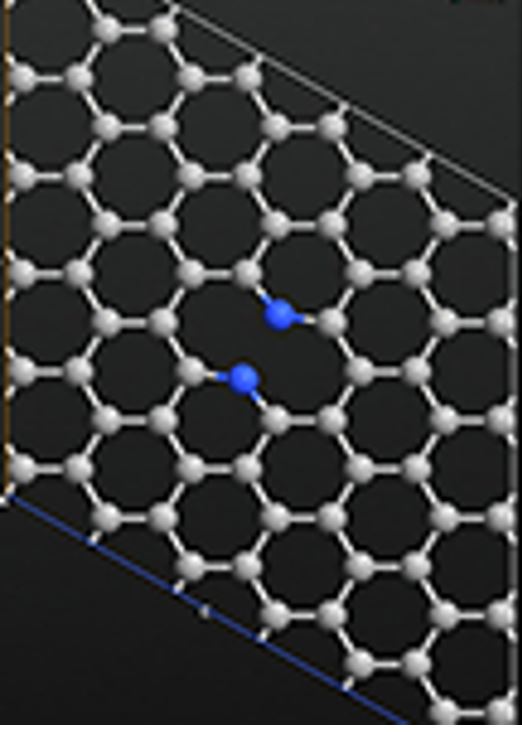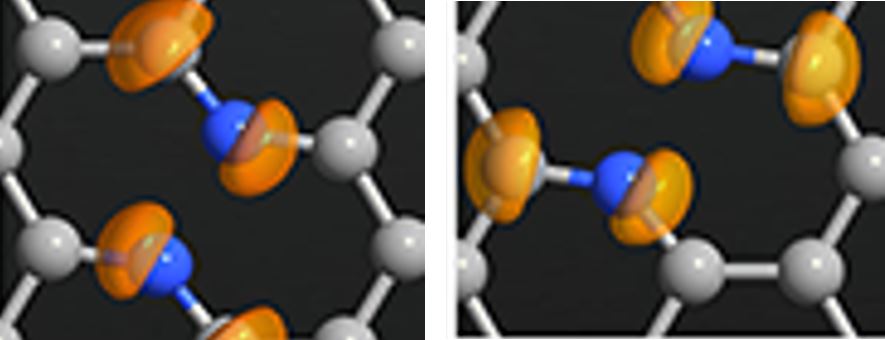- Details
- Last Updated: Tuesday, 27 December 2022 18:23
Vacancy-Nitrogen Centers in Graphene for Qubits and Vacancy-Nitrogen Linear Arrays for Quantum Data Transfer
Goals: A new method for generating in a controlled fashion vacancies and vacancy arrays in graphene sheet has been discovered by Sahtout and Karoui. The vacancies are doped with nitrogen to create NV centers, which are useful for many applications: quantum devices, high efficiency catalyst,... Some of our goals is to understand the properties of these centers as single quantum entity or ordered array of the same, and to provide means to use them as elements for quantum devices. Pairs of NV complexes appear to be promising for making interesting bistable quantum systems, useful for instance for qubits. Furthermore, Karoui and Sahtout proposed that the intrinsic and doped vacancy lines can be used in quantum circuits for data transfer.
|
Nitrogen-Vacancy (NV) centers in graphene have been proposed by Karoui and Sahtout as a promising platform for qubit fabrication. They have suggested that the generation of ordered vacancy (V) arrays in graphene can be achieved in a controlled manner under sustained tensile strain, provided that the dynamics of vacancy generation are understood. We studied the dynamics of single V and V array formation in pristine graphene sheet under tensile load using Molecular Dynamics (MD) calculations with LAMMPS. The MD was done for uniaxial loads and employing AIREBO potential. The capability of AIREBO potential to accurately capture the interactions of carbon atoms in graphene was tested. To that end an atomic system of several million atoms has been used for accuracy and to minimize the edge effects. The carbon-based interactions in AIREBO are parameterized with cut-off function that truncates the potential energy between certain inner and outer cut-off interatomic distances. Improper cut-off values resulted in under or over-coordination between atoms, which led to non-physical interactions and properties. Runs on Solo supercomputer with AIREBO “as is”, produced stress-strain curves of graphene similar to those of brittle materials, and mechanical properties were very close to experimental data. |
NV complex in graphene generated in a controlled fashion by applying a tensile strain. |
|
For the first time, we could observe during the plastic regime, the complete dynamics of single V, V array and crack formation in pristine graphene. Note that published work on defect propagation in graphene started with defected graphene sheets [2]. Our LAMMPS MD calculations were performed on Solo supercomputer. For such a very large atomic system the Intel compiler allowed minimizing the propagation of round-off errors better than any other supercomputing environment we have tested. We consistently obtained the formation of single V then V array parallel to the pulling direction. Under the tensile load vacancies cluster in vacancy lines (VL). Each VL is bordered on one side with a single-atom Klein edge defect and on the opposite side with a zigzag edge. The first V appears at 4.2% strain as a result of a stress of 35 GPa in the pulling direction (i.e., // to the zigzag). The V line appears at 5.4% strain, at a stress of 44 GPa with an average interval of 7 C-cycles (equal to 16A spacing). As we pursue the loading, we consistently observed a mirror defect image parallel to the original VL emerges. The graphene patch between the two VLs keeps sliding through successive “zipping” and “unzipping” of the VLs. Subsequent load increase generates several vacancy line-pairs.
|
NV center in graphene is a new bi-stable system proposed by Karoui et Sahtout, who propose the utilization of arrays of such center for making qubits for quantum computing.
|
STILL UNDER CONSTRUCTION
(please come back later)


